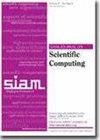针对分散海啸传播的隐式自适应网格细化
IF 2.6
2区 数学
Q1 MATHEMATICS, APPLIED
引用次数: 0
摘要
SIAM 科学计算期刊》,第 46 卷第 4 期,第 B554-B578 页,2024 年 8 月。 摘要我们提出了一种利用基于补丁的自适应网格细化求解色散深度平均 Serre-Green-Naghdi 方程的算法。这些方程需要在非线性浅水方程中添加额外的高导数项。这已作为开源 GeoClaw 软件的一个新组件实施,该软件被广泛用于海啸、风暴潮和相关灾害的建模,提高了其对较短波长现象的精度。我们使用的方法需要在每个时间步求解一个椭圆方程组,因此该方法是隐式的。自适应算法允许在不同细化级别上采用不同的时间步长,并逐级求解隐式方程。计算实例展示了一个径向对称测试案例和两个现实海啸建模问题的稳定性和准确性,包括一个假想的小行星撞击产生的短波长海啸,其中分散项是必要的。计算结果的可重复性。本文被授予 "SIAM 可重现徽章":代码和数据可用",以表彰作者遵循了 SISC 和科学计算界重视的可重现性原则。读者可以通过 https://github.com/rjleveque/ImplicitAMR-paper 和补充材料(ImplicitAMR-paper.zip [174KB])中的代码和数据重现本文的结果。本文章由计算机程序翻译,如有差异,请以英文原文为准。
Implicit Adaptive Mesh Refinement for Dispersive Tsunami Propagation
SIAM Journal on Scientific Computing, Volume 46, Issue 4, Page B554-B578, August 2024.
Abstract. We present an algorithm to solve the dispersive depth-averaged Serre–Green–Naghdi equations using patch-based adaptive mesh refinement. These equations require adding additional higher derivative terms to the nonlinear shallow water equations. This has been implemented as a new component of the open source GeoClaw software that is widely used for modeling tsunamis, storm surge, and related hazards, improving its accuracy on shorter wavelength phenomena. We use a formulation that requires solving an elliptic system of equations at each time step, making the method implicit. The adaptive algorithm allows different time steps on different refinement levels and solves the implicit equations level by level. Computational examples are presented to illustrate the stability and accuracy on a radially symmetric test case and two realistic tsunami modeling problems, including a hypothetical asteroid impact creating a short wavelength tsunami for which dispersive terms are necessary. Reproducibility of computational results. This paper has been awarded the “SIAM Reproducibility Badge: Code and data available” as a recognition that the authors have followed reproducibility principles valued by SISC and the scientific computing community. Code and data that allow readers to reproduce the results in this paper are available at https://github.com/rjleveque/ImplicitAMR-paper and in the supplementary materials (ImplicitAMR-paper.zip [174KB]).
Abstract. We present an algorithm to solve the dispersive depth-averaged Serre–Green–Naghdi equations using patch-based adaptive mesh refinement. These equations require adding additional higher derivative terms to the nonlinear shallow water equations. This has been implemented as a new component of the open source GeoClaw software that is widely used for modeling tsunamis, storm surge, and related hazards, improving its accuracy on shorter wavelength phenomena. We use a formulation that requires solving an elliptic system of equations at each time step, making the method implicit. The adaptive algorithm allows different time steps on different refinement levels and solves the implicit equations level by level. Computational examples are presented to illustrate the stability and accuracy on a radially symmetric test case and two realistic tsunami modeling problems, including a hypothetical asteroid impact creating a short wavelength tsunami for which dispersive terms are necessary. Reproducibility of computational results. This paper has been awarded the “SIAM Reproducibility Badge: Code and data available” as a recognition that the authors have followed reproducibility principles valued by SISC and the scientific computing community. Code and data that allow readers to reproduce the results in this paper are available at https://github.com/rjleveque/ImplicitAMR-paper and in the supplementary materials (ImplicitAMR-paper.zip [174KB]).
求助全文
通过发布文献求助,成功后即可免费获取论文全文。
去求助
来源期刊
CiteScore
5.50
自引率
3.20%
发文量
209
审稿时长
1 months
期刊介绍:
The purpose of SIAM Journal on Scientific Computing (SISC) is to advance computational methods for solving scientific and engineering problems.
SISC papers are classified into three categories:
1. Methods and Algorithms for Scientific Computing: Papers in this category may include theoretical analysis, provided that the relevance to applications in science and engineering is demonstrated. They should contain meaningful computational results and theoretical results or strong heuristics supporting the performance of new algorithms.
2. Computational Methods in Science and Engineering: Papers in this section will typically describe novel methodologies for solving a specific problem in computational science or engineering. They should contain enough information about the application to orient other computational scientists but should omit details of interest mainly to the applications specialist.
3. Software and High-Performance Computing: Papers in this category should concern the novel design and development of computational methods and high-quality software, parallel algorithms, high-performance computing issues, new architectures, data analysis, or visualization. The primary focus should be on computational methods that have potentially large impact for an important class of scientific or engineering problems.

 求助内容:
求助内容: 应助结果提醒方式:
应助结果提醒方式:


